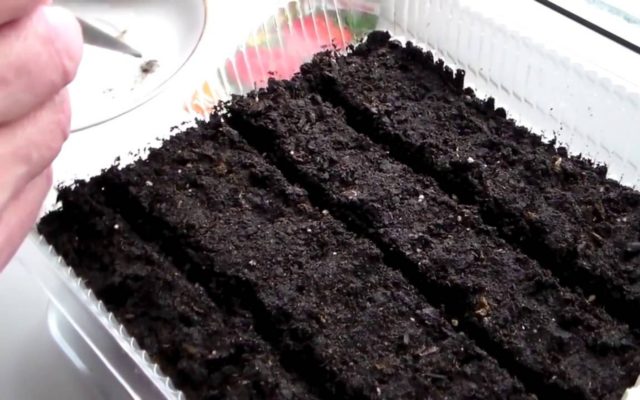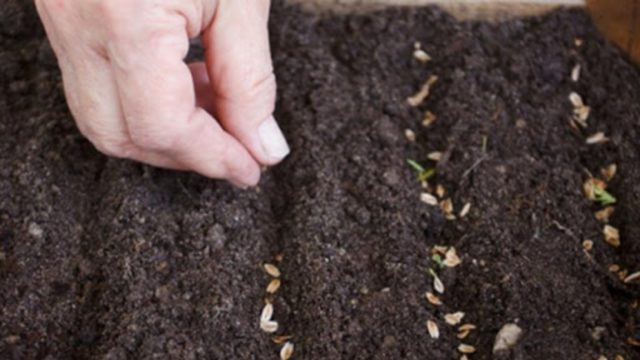Content
Brunner Alexander Great is a large-leaved crop that was bred thanks to the efforts of the Belarusian breeder Alexander Zuykevich. The variety is valued for its unpretentiousness and high decorative qualities, which it retains until the onset of frost. This explains the widespread use of the species in landscape design. This variety is ideally combined with ferns, hosts, astilbe, geyher, as it also prefers shady areas in the garden.
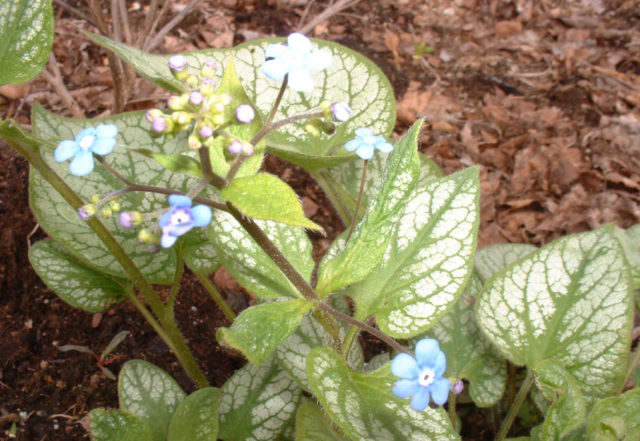
Brunner is used in shady mixborders, as a border
Description of brunners Alexander Great
This variety stands out noticeably against the background of other species with its huge leaves, which add volume to the bush. As a result of this brunner, "Alexander Great" looks especially smart. The height of the shrub reaches 60 cm, and the diameter is about 70 cm.The length of the plates is 30 cm, and the width is 15-20 cm.
The leaves of the brunner "Alexander Great" are heart-shaped, silvery-white with green veins and a narrow border around the edges, which gives the impression of an unusual ornament.
The flowers of this variety are small, 0.5-1.0 cm in diameter, resemble forget-me-nots in shape. They are collected in loose inflorescences. The color of the petals is pale blue. The plant forms flower stalks in late spring - early summer. They confidently rise above the leaves. The flowering time of the Alexander Great brunner is 3-4 weeks. But under favorable conditions, the variety can bloom again in the fall, but not so abundantly. The fruits of the plant are a small nut.
Growing from seeds
Even a novice gardener is quite capable of growing a brunner "Alexander Great". To do this, it is necessary to purchase high-quality varietal seeds so that the grown seedlings ultimately correspond to the selected variety.
Sowing should be done in December. To do this, prepare wide containers with a height of 8-10 cm with drainage holes. You can prepare the soil mixture for Brunner yourself. To do this, you need to mix the following components:
- 2 pieces of turf;
- 1 part of humus;
- 1 part coconut substrate
- 1 part peat.
The day before sowing, the substrate must be shed with a bright pink solution of potassium permanganate, and then dried a little. This will prevent the development of fungal diseases at the initial stage of seedling growth.
Algorithm of actions:
- Lay drainage on the bottom of the container in a layer of 1 cm.
- Fill the rest of the volume with the substrate, lacking 1 cm of water to the upper edge.
- Water the soil, wait until the water is completely absorbed.
- Make grooves 0.5 cm deep.
- Place seeds in them, sprinkle with soil.
After sowing, the container should be covered with foil and placed in the vegetable section of the refrigerator for 3 months. Thus, seed stratification occurs, which stimulates growth processes.
At the end of February, containers should be placed on the windowsill and provided with a mode of + 18-19 degrees. Seedlings will germinate in 3-4 weeks. When the Brunner sprouts get a little stronger, they need to be adapted to external conditions. To do this, for the first time, remove the film for half an hour, and with each subsequent day, increase the interval by another 30-40 minutes. After a week, the seedlings can be fully opened.
When the seedlings grow up, you need to transplant the strongest into separate containers with a diameter of 5-7 cm.And to accelerate the development of the root system, you should pour them with a solution of "Kornevin" (5 g per 5 l).
Before planting on a permanent place, the seedlings of the brunner "Alexander Great" need to be hardened. To do this, a week before the procedure, you must begin to take it out into the street in a shaded place. Initially by 1 hour, and every day increase the interval by another 1-2 hours. One day before planting, the seedlings can be left outside overnight.
Landing in the ground
In order for this culture to fully develop and bloom regularly, it is necessary to properly plant, taking into account its requirements. Failure to comply with the basic recommendations leads to a decrease in the decorative effect of the brunner, and sometimes to its death.
Site selection and preparation
In its natural environment, this culture prefers to grow in a forest area under the shade of trees. Therefore, for the landing of the Alexander Great brunners, shaded, slightly damp areas should be selected. The culture develops well in clay soil.

When placing the plant in a sunny place, burns appear on the leaves.
It is necessary to plant the grown seedlings of the brunner "Alexander Great" in open ground at the end of July - at the beginning of August. This will allow the plants to take root and adapt before winter arrives.
2 weeks before this, the site should be dug up, all roots of perennial weeds should be removed. You should also make 1 sq. m. 5 kg of humus, 30 g of superphosphate and 15 g of potassium sulfate.
Planting stages
Planting of Alexander Great brunner saplings should be carried out according to the standard scheme. To do this, make holes 8 cm deep at a distance of 60 cm from each other. At the bottom of each hole, you need to pour some sand, and then water the soil. Transplanting seedlings should be carried out without disturbing the earthy clod at the roots.
Then sprinkle a little earth and compact the soil at the base of the brunner seedlings. One day after planting, the soil should be mulched with peat and tree bark. This will prevent excessive evaporation of moisture from the soil and overheating of the root system.
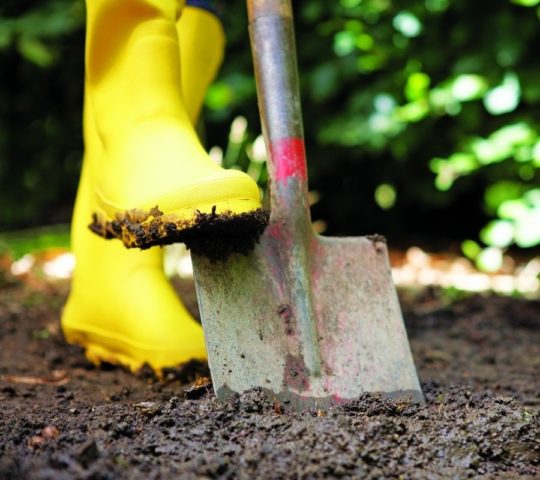
The site for the brunner needs to be prepared in advance
Care
Brunner's "Alexander Great" is undemanding to care, which contributes to the growth of its popularity. It is necessary to water the plant only in the absence of seasonal rains, and the rest of the time it is able to independently provide itself with moisture. It is impossible to loosen the soil at the base of the bushes, as this leads to damage to the root system. Therefore, it is sufficient to simply remove the weeds throughout the season.
It is necessary to feed the brunner "Alexander Great" at the beginning of the growing season in the spring. During this period, you need to apply mineral nitrogen fertilizers. The second time feeding is carried out after flowering. At this time, phosphorus-potassium mixtures should be used, which will increase the immunity of the culture.
Diseases and pests
Large-leaved brunner "Alexander Great" has increased resistance to pests and diseases. However, non-compliance with growing conditions can cause the development of powdery mildew and brown spot. In this case, you need to treat the bushes with Bordeaux mixture or Hom.
Of the pests, the danger for the brunner is aphid, which feeds on the sap of young leaves and peduncles of the plant. When the first signs of damage appear, you need to treat it with Confidor Extra.
In rainy summers, Brunner leaves can damage slugs. To prevent this, you need to sprinkle the soil at the base of the bushes with tobacco dust or wood ash.
Pruning
"Alexander Great" does not require cardinal cutting of the brunner. It is enough only during the season to remove damaged leaves and wilted peduncles, which reduce its decorative qualities.
Preparing for winter
With the first frosts, withered brunner leaves must be cut off at the base, leaving hemp no higher than 5 cm.Then sprinkle the root with a thick layer of peat or humus to prevent it from freezing.This plant does not need additional shelter for the winter.
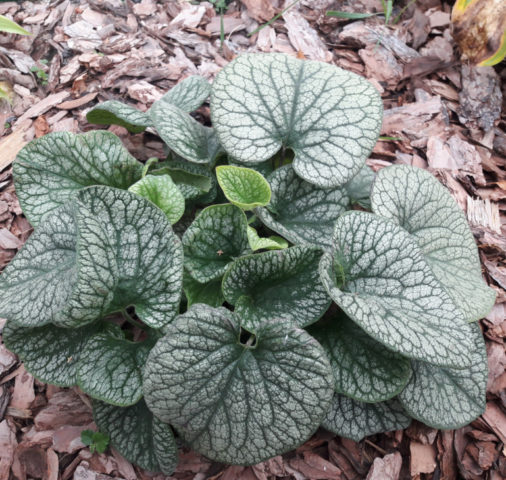
The land around Brunner needs to be constantly mulched.
Reproduction
This Brunner variety can be propagated by dividing the bush. To do this, in August, you need to dig up an adult plant bush, clean the roots from the soil, use a knife to cut it into separate segments. Each of them must have a growing point and a well-developed root process. After that, the seedlings must be immediately planted in a permanent place.
Photo in landscape design
How the brunner "Alexander Great" looks in combination with other plants can be seen in the proposed photos.

Looks good along the garden path

The plant gets along well with the dicenter

Brunner can also successfully disguise unsightly areas near buildings.
Conclusion
Brunner Alexander Great is a highly decorative crop variety that can give the shady places of the site a well-groomed beautiful look. At the same time, the plant does not require increased attention to itself, it is enough only to water in rare cases and fertilize twice a year. And not every perennial has such qualities.
